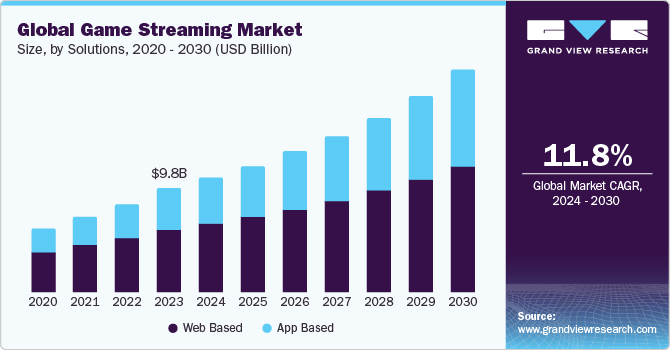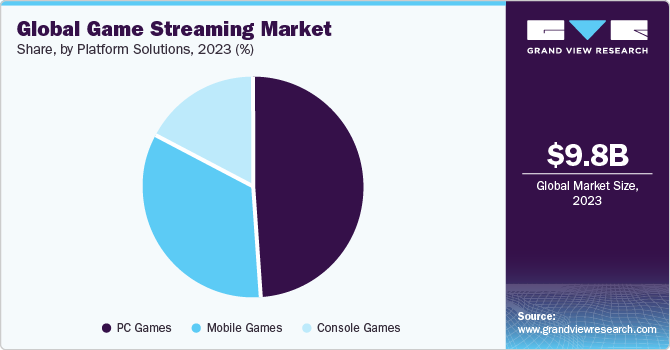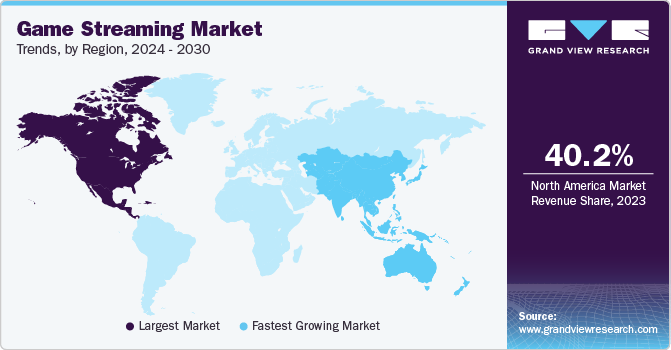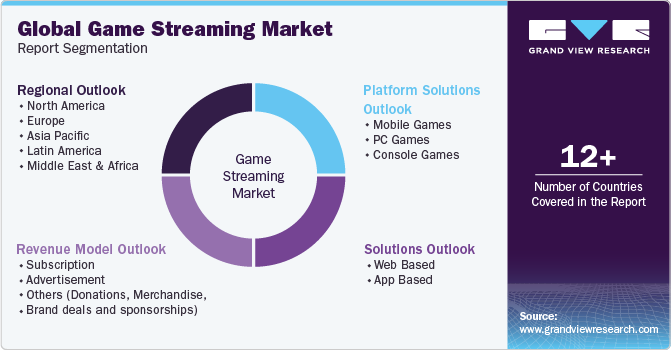
Game Streaming Market Size, Share & Trends Analysis Report By Solutions (Web-based, App-based), By Revenue Model, By Platform Solutions (PC, Console), By Region, And Segment Forecasts, 2024 - 2030
- Report ID: GVR-4-68040-270-4
- Number of Report Pages: 150
- Format: PDF
- Historical Range: 2017 - 2022
- Forecast Period: 2024 - 2030
- Industry: Technology
Game Streaming Market Size & Trends
The global game streaming market size was estimated at USD 9.8 billion in 2023 and is projected to grow at a CAGR of 11.8% from 2024 to 2030. The growing popularity of smartphones and the capability of portable devices is driving the mobile gaming sector, and game streaming services are realizing this. These businesses are creating specialized mobile apps for easy access, streamlining streaming technology for lower latency experiences on mobile networks, and modifying their platforms to support mobile gaming. Additionally, they are utilizing mobile-specific elements, such as accelerometer inputs and touch controllers, to improve gameplay experiences catered to the special qualities of mobile devices. Game streaming services are gaining traction among both casual and die-hard gamers due to the availability of console-caliber games on smartphones. This is revolutionizing the way people play and access games while on the go.

The live streaming landscape has witnessed a surge in popularity, with platforms like Twitch leading the charge. While Twitch's roots lie in gaming, and this dominance is likely to persist, it's strategically branching out into music, talk shows, and creative content for a more comprehensive offering. This diversification is crucial as competition heats up from rivals like Facebook Gaming and YouTube Gaming. Twitch boasts robust monetization options for its streamers, solidifying its position within the market. To further elevate the user experience, these platforms are embracing interactive features like chatbots and polls, fostering deeper audience engagement.
Game streaming platforms are diversifying their revenue streams beyond traditional subscription models to ensure long-term financial sustainability. They're embracing micro transactions, in-game purchases, and virtual goods sales as additional monetization avenues, allowing users to personalize their gaming experiences and support developers directly. Moreover, they're exploring hybrid models that combine free-to-play content with premium subscriptions or ad-supported features to cater to a broader audience while still generating revenue. By offering flexibility in how users can spend and support their favorite games, streaming platforms are fostering a healthy gaming ecosystem where developers can thrive and innovate while providing value to players.
Web-based game streaming platforms are prioritizing accessibility and cross-platform compatibility to reach a broader audience of gamers. By offering streaming services that can be accessed directly through web browsers, platforms eliminate the need for users to download and install dedicated apps or software, streamlining the gaming experience and making it more convenient for players to jump into their favorite games from any device. This trend is particularly beneficial for casual gamers and those with lower-spec hardware who may not have access to dedicated gaming consoles or PCs, democratizing access to high-quality gaming experiences across desktops, laptops, tablets, and smartphones.
Market Concentration & Characteristics
The market is characterized by a high degree of innovation as platforms are continuously innovating in streaming technology to enhance video quality, reduce latency, and improve overall reliability. Optimization of video codecs and implementation of content delivery networks (CDNs) ensure high-resolution and low-latency streaming experiences, even with limited bandwidth. Edge computing technologies minimize latency and enable real-time interactions in multiplayer games. These advancements collectively contribute to a more immersive and responsive gaming experience, driving user satisfaction and platform adoption.

The game streaming industry is changing due to a large amount of merger and acquisition (M&A) activity. In order to increase their market, share and improve their service offerings, larger firms deliberately buy out smaller platforms or startups. A proactive strategy to take advantage of the expanding market and exploit synergies for improved performance and innovation across platforms is shown in this consolidation.
Regulations, particularly those regarding online gambling, copyright infringement, and age restrictions, directly impact the availability and distribution of content on game streaming platforms. Government interventions can lead to the removal or restriction of certain games or content types, affecting platform offerings and user experiences. Additionally, regulatory requirements may influence content licensing agreements and distribution strategies, shaping the content landscape and platform competitiveness. Platforms must adapt their content policies and licensing practices to comply with regulations while maintaining a diverse and engaging content library.
The rise of cloud gaming services heralds a significant shift in the market, fundamentally transforming how games are accessed, played, and delivered. These services harness powerful servers to stream games directly to users' devices, eliminating the need for costly hardware and facilitating smooth gameplay across various platforms. Leading platforms such as Google Stadia, Microsoft xCloud, and NVIDIA GeForce Now employ subscription-based models, granting users access to an extensive library of games on demand. As cloud gaming gains momentum, it presents a formidable challenge to traditional game streaming platforms, offering enhanced performance, convenience, and accessibility. To stay competitive in this evolving landscape, traditional platforms must adapt their offerings accordingly.
End-use concentration is also influenced by key content creators who wield significant influence over their audience and can concentrate user attention around their channels or streams. Influential streamers with large followings often dictate trends, drive engagement, and shape the content landscape within the game streaming ecosystem. Consequently, platforms may experience fluctuations in user activity based on the presence or absence of popular content creators, highlighting the importance of creator partnerships and retention strategies for platform growth. Moreover, the rise of celebrity gamers and esports personalities further amplifies the concentration of end-users around influential individuals and their content.
Solutions Insights
The web-based segment led the market and accounted for 60.9% of the global revenue in 2023. Many web-based game streaming services have adopted subscription-based business models, offering access to a library of games for a monthly or annual fee. This model aligns with consumer preferences for subscription services and provides a convenient and cost-effective way for gamers to access a wide range of titles without purchasing individual games. Subscription models can also foster a more sustainable revenue stream for platform providers and game developers. However, maintaining a diverse and regularly updated game library is crucial to retain subscribers and justify the recurring cost.
As the app-based game streaming segment grows, developers and platform providers are focusing on optimizing the gaming experience for mobile platforms. This includes optimizing user interfaces to make them intuitive and responsive on smaller screens, implementing tailored input methods like touch controls and gamepad support, and ensuring smooth performance across various mobile hardware configurations and network conditions. Optimizing for diverse mobile ecosystems, such as iOS and Android, with their unique capabilities and limitations, is crucial for delivering a consistent and high-quality gaming experience across different devices.
Revenue Model Insights
The advertisement segment led the market with the highest revenue share in the 2023. Streamers are exploring new ways to generate income beyond traditional ad revenue. These options include paid subscriptions, tiered membership programs, and exclusive content offerings. Streamers may also partner with brands to sell custom merchandise directly to viewers. This diversification of revenue streams benefits both streamers and advertisers, as it opens up more avenues for brand collaboration and viewer engagement.
Major game streaming platforms like Microsoft's Xbox Game Pass, Sony's PlayStation Plus, and NVIDIA's GeForce Now have embraced subscription-based models, offering access to a library of games for a recurring fee. This approach has gained popularity among gamers as it provides a cost-effective way to access a diverse range of titles without purchasing individual games outright. The convenience and value proposition of these services have contributed to their growth and adoption. However, the success of these services centers on curating a compelling game library that caters to diverse gaming preferences and is regularly refreshed with new additions.
Platform Solutions Insights
The PC games segment led the market with the highest revenue share in 2023. PC gaming plays a central role in the e-sports scene, with popular titles such as League of Legends, Counter-Strike: Global Offensive, Dota 2 and various others. Streaming platforms enable fans to watch high-level competitive play, driving interest and engagement. E-sports has become a significant industry with sponsorships, advertising, and merchandise sales, benefiting both players and streamers. This trend continues to boost the profile of PC gaming on a global scale.

Mobile games like PUBG Mobile, Clash Royale, Free Fire and various others are making significant strides in the e-sports scene, attracting large audiences and professional players. Mobile game streaming platforms are capitalizing on this trend by hosting live e-sports events and tournaments. This growth has led to increased sponsorships, advertising, and prize pools within the mobile gaming e-sports ecosystem. Moreover, mobile game streamers are exploring new monetization strategies such as in-stream ads and donations from viewers. Streamers can earn revenue by displaying ads during their broadcasts or receiving tips from their audience. This trend allows streamers to create sustainable income streams while offering viewers options to support their favorite content creators.
Regional Insights
North America dominated the games streaming market and accounted for a 40.19% share in 2023. North American streamers prioritize building strong communities around their channels. This includes interacting with viewers in chat, creating Discord servers for discussions, and organizing community events. These efforts help foster loyalty and engagement among viewers, leading to more stable viewership and potential growth in monetization opportunities.

U.S. Game Streaming Market Trends
The game streaming market in the U.S. has seen significant growth in the popularity of live streaming platforms for gaming, such as Twitch, YouTube Gaming, and Facebook Gaming. These platforms have attracted millions of viewers and content creators, driving the growth of the game streaming market in the country. Major e-sports events and tournaments are frequently streamed on these platforms, further fueling their growth.
Europe Game Streaming Market Trends
The game streaming market in Europe has witnessed a rapid adoption of cloud gaming services, driven by the availability of high-speed internet infrastructure and the increasing demand for accessible gaming experiences. Major cloud gaming platforms like Google Stadia, NVIDIA GeForce Now, and Amazon Luna have focused their efforts on expanding their presence in the European market.
The UK game streaming market is growing as streaming platforms and content creators have explored various monetization strategies, such as subscriptions, virtual item sales, and sponsorships. Subscription-based models, where users pay a recurring fee for access to game libraries or premium features, have gained popularity in the market.
The game streaming market in France is growing as streaming platforms have focused on providing accessible gaming experiences to French audiences. This includes offering cloud gaming services, optimizing for a wide range of devices, and catering to users with diverse gaming preferences and skill levels.
Germany game streaming market has emerged as a significant hub for esports and competitive gaming. Major tournaments and leagues, such as the ESL One and Intel Extreme Masters, have been held in cities like Cologne and Katowice, attracting large audiences and investments. The country has a thriving esports ecosystem, with dedicated teams, venues, and sponsors.
Asia Pacific Game Streaming Market Trends
The game streaming market in Asia Pacific is anticipated to register the fastest CAGR over the forecast period. The rise of cloud gaming services like Google Stadia could act as a further catalyst for game streaming. These services allow users to play demanding games without needing powerful hardware, potentially expanding the audience for streamed content. Cloud gaming integration within streaming platforms could remove technical barriers for some viewers, opening doors to a wider range of streamed gaming experiences.
China game streaming market has witnessed a rapid growth in the popularity of live streaming platforms for gaming, such as Douyu, Huya, and Bilibili. These platforms have attracted millions of viewers and content creators, driving the expansion of the game streaming market in the country.
The game streaming market in India is growing with the widespread adoption of smartphones and affordable mobile data plans has fueled the growth of mobile gaming and streaming across various markets. Platforms have optimized their offerings for mobile devices, enabling users to conveniently stream and watch games on-the-go. Mobile e-sports tournaments and events have also gained popularity, reflecting the rising trend of competitive mobile gaming. This trend has been particularly strong in markets like India, where mobile gaming has become a significant driver of the game streaming industry.
Japan game streaming market is growing as, despite the popularity of mobile gaming and e-sports, Japan's traditional gaming culture remains influential in the streaming scene. Many Japanese streamers and viewers have a strong affinity for classic console and PC games, leading to a steady stream of content focused on retro gaming and nostalgia-driven experiences.
Middle East & Africa (MEA) Game Streaming Market Trends
Cultural factors significantly influence the games streaming market in the MEA region, shaping the types of content that resonate with local audiences. Multiplayer and social gaming experiences are particularly popular, reflecting the region's emphasis on community and social interaction. Game streaming platforms adapt to these cultural preferences by featuring content that reflects the diversity of the region's cultures and languages, ensuring that users feel represented and engaged with the content they consume.
Key Game Streaming Company Insights
Major corporations are leveraging a mix of strategic initiatives to expand their market reach. These tactics include expansions, product launches, partnerships, mergers and acquisitions, and collaborations. This multifaceted approach allows them to gain market share and solidify their position within competitive industries. In December 2023, NVIDIA Corporation showcased its commitment to growth by launching high-performance cloud gaming across North America and Europe. This service utilizes newly deployed GeForce RTX 4080 SuperPODs to deliver exceptional streaming experiences. Users can now enjoy gameplay at up to 240 frames per second or 4K resolution at 120 fps on native PC and Mac applications, with additional support for ultrawide resolutions.
Key Game Streaming Companies:
The following are the leading companies in the game streaming market. These companies collectively hold the largest market share and dictate industry trends.
- Alphabet Inc. (Youtube)
- Amazon.com Inc.
- Meta Platforms Inc.
- Apple Inc.
- Genvid Holdings Inc.
- GosuGamers
- Huya
- AfreecaTV Corp.
- NVIDIA Corp.
- Parsec Cloud Inc.
- Sony Group Corp.
Recent Developments
-
In January 2024, AfreecaTV unveiled plans to launch a beta version of its new live-streaming platform, SOOP, during the first half of 2024. This initiative reflects the company's commitment to fostering a vibrant and inclusive environment where users, streamers, and partners can actively participate and shape the future of the live-streaming community.
-
In March 2023, Optus partnered with Pentanet Limited to bring NVIDIA's GeForce NOW cloud gaming service to their Australian customers. Cloud gaming is a rapidly growing market segment that offers greater flexibility and convenience for gamers, allowing them to play demanding games from anywhere. This technology relies heavily on high-speed, low-latency internet connections, making it a perfect fit for Optus' advanced 5G network. This collaboration aims to provide Optus customers with a seamless and adaptable cloud gaming experience. The service will leverage the strengths of both companies: Optus' powerful 5G network with its innovative Living Network features and Pentanet's expertise in managing GeForce NOW through the CloudGG platform. By integrating GeForce NOW with Optus' SubHub subscription platform, Optus customers will have easy access to this cutting-edge gaming technology.
-
In August 2023, GeForce NOW has unveiled the introduction of the Ultimate KovvaK's challenge, aimed at assisting gamers in refining their aim while offering a time-limited Steam discount. Leveraging its GPUs and advanced software, the company's gaming platforms elevate users' gaming experiences by delivering superior graphics quality. Among these offerings is GeForce Experience, a gaming application tailored to optimize PC users' settings for individual applications, empowering gamers to capture and distribute their gameplay seamlessly.
Game Streaming Market Report Scope
|
Report Attribute |
Details |
|
Market size value in 2024 |
USD 10.85 billion |
|
Revenue forecast in 2030 |
USD 21.20 billion |
|
Growth Rate |
CAGR of 11.8% from 2024 to 2030 |
|
Base year for estimation |
2023 |
|
Historical data |
2017 - 2022 |
|
Forecast period |
2024 - 2030 |
|
Quantitative units |
Revenue in USD million/billion and CAGR from 2024 to 2030 |
|
Report coverage |
Revenue forecast, company ranking, competitive landscape, growth factors, and trends |
|
Segments covered |
Solutions, revenue model, platform solutions, region |
|
Regional scope |
North America; Europe; Asia Pacific; Latin America; and MEA |
|
Country scope |
U.S.; Canada; Mexico; UK; Germany; France; China; Japan; India; South Korea; Australia; Brazil; UAE; Saudi Arabia (KSA); South Africa |
|
Key companies profiled |
AfreecaTV Corp.; Alphabet Inc. (Youtube); Amazon.com Inc.; Apple Inc.; Genvid Holdings Inc.; GosuGamers; Huya; Meta Platforms Inc.; NVIDIA Corp.; Parsec Cloud Inc.; Sony Group Corp. |
|
Customization scope |
Free report customization (equivalent up to 8 analysts working days) with purchase. Addition or alteration to country, regional & segment scope. |
|
Pricing and purchase options |
Avail customized purchase options to meet your exact research needs. Explore purchase options |
Global Game Streaming Market Report Segmentation
This report forecasts revenue growth at global, regional, and country levels and provides an analysis of the latest industry trends in each of the sub-segments from 2017 to 2030. For this study, Grand View Research has segmented the global game streaming market report based on solutions, revenue model, platform solutions and region.

-
Solutions Outlook (Revenue, USD Million, 2017 - 2030)
-
Web based
-
App based
-
-
Revenue Model Outlook (Revenue, USD Million, 2017 - 2030)
-
Subscription
-
Advertisement
-
Others (Donations, Merchandise, Brand deals and sponsorships)
-
-
Platform Solutions Outlook (Revenue, USD Million, 2017 - 2030)
-
Mobile Games
-
PC Games
-
Console Games
-
-
Regional Outlook (Revenue, USD Million, 2017 - 2030)
-
North America
-
U.S.
-
Canada
-
Mexico
-
-
Europe
-
Germany
-
UK
-
France
-
-
Asia Pacific
-
China
-
Japan
-
India
-
South Korea
-
Australia
-
-
Latin America
-
Brazil
-
-
Middle East and Africa (MEA)
-
UAE
-
KSA
-
South Africa
-
-
Frequently Asked Questions About This Report
b. The global game streaming market size was estimated at USD 9.8 billion in 2023 and is expected to reach USD 10.85 billion in 2024.
b. The global game streaming market is expected to grow at a compound annual growth rate of 11.8% from 2024 to 2030 to reach USD 21.20 billion by 2030.
b. North America dominated the game streaming market, with a share of 40.19% in 2023. Platforms like Twitch, YouTube Gaming, and Facebook Gaming have become increasingly popular in North America, enabling gamers to stream their gameplay and interact with viewers, which is increasing the region's growth.
b. Some key players operating in the game streaming market include Alphabet Inc. (Youtube), Amazon.com Inc., Meta Platforms Inc., Apple Inc., Genvid Holdings Inc., GosuGamers, Huya, AfreecaTV Corp., NVIDIA Corp., Parsec Cloud Inc., Sony Group Corp.
b. Key factors that are driving the market growth include Increasing demand for on-demand entertainment and advancements in technology, and the rise of cloud gaming and high-speed internet access are key factors fueling the expansion of the game streaming market..
We are committed towards customer satisfaction, and quality service.
"The quality of research they have done for us has been excellent."




